Popular Content
Want Email Updates?
Get emails about new stuff.
Be the first to know.
Looking for Something?
Figurative Language Worksheets
Common Core State Standards demand that students identify figurative language techniques. This means that your standardized test is likely to question figurative language knowledge. Students can prepare for this through repeated exposure to figurative language. You can do this by studying figurative language poems, activities, or the worksheets on this page.
These worksheets will give students rapid fire practice with figurative language techniques. Not only must students identify the techniques, they must explain their answers. This approach forces students to consider their answers. It also helps teachers identify misunderstandings.
Figurative Language Worksheet 1
Here is a ten-problem figurative language worksheet. It will give students rapid-fire practice with identifying figurative language techniques. Students read the examples, identify the technique, and then explain their answer.
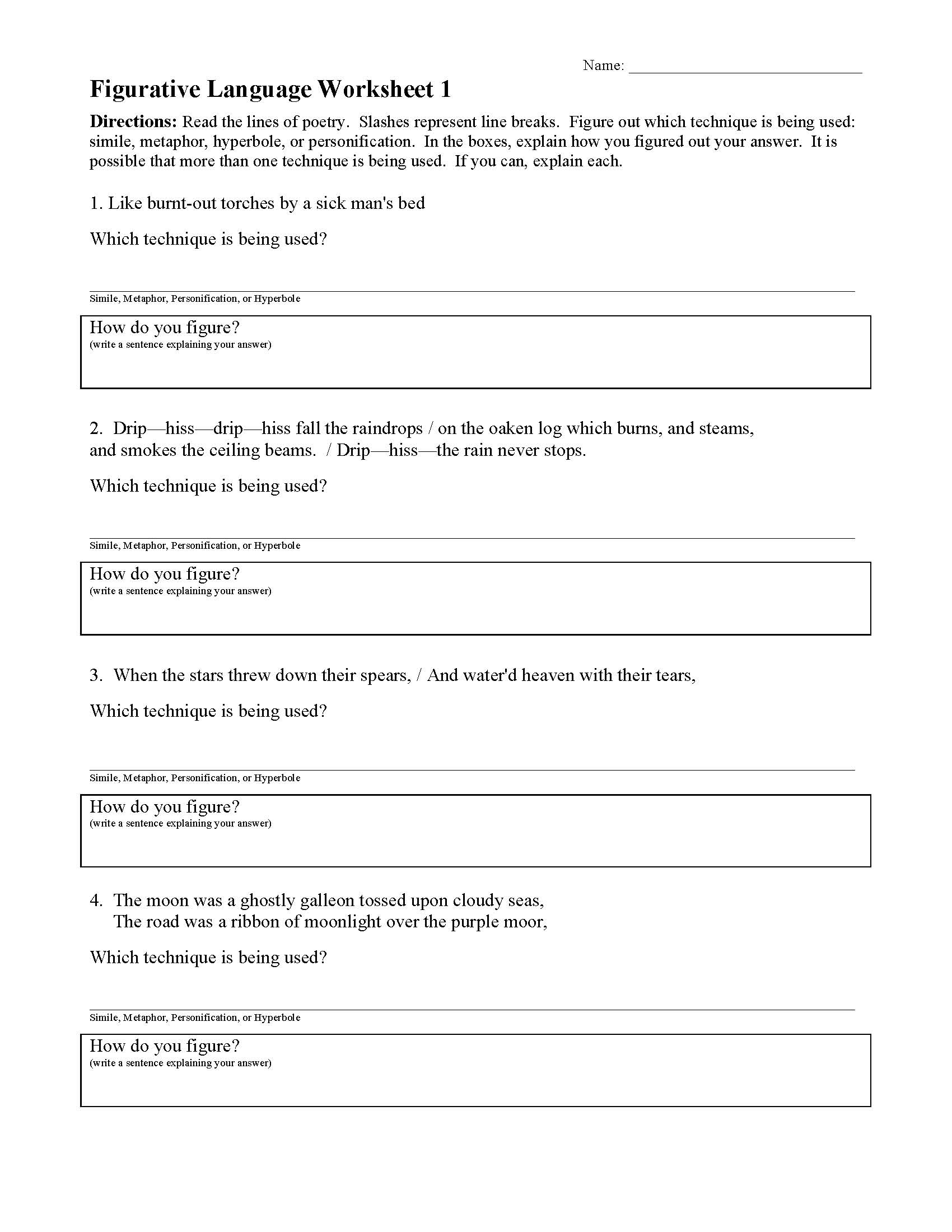
Figurative Language Worksheet 2
Here is another ten-problem worksheet to give students practice identifying figurative language techniques. Students will read the poetic snippets, identify the figurative techniques, and explain their answers.
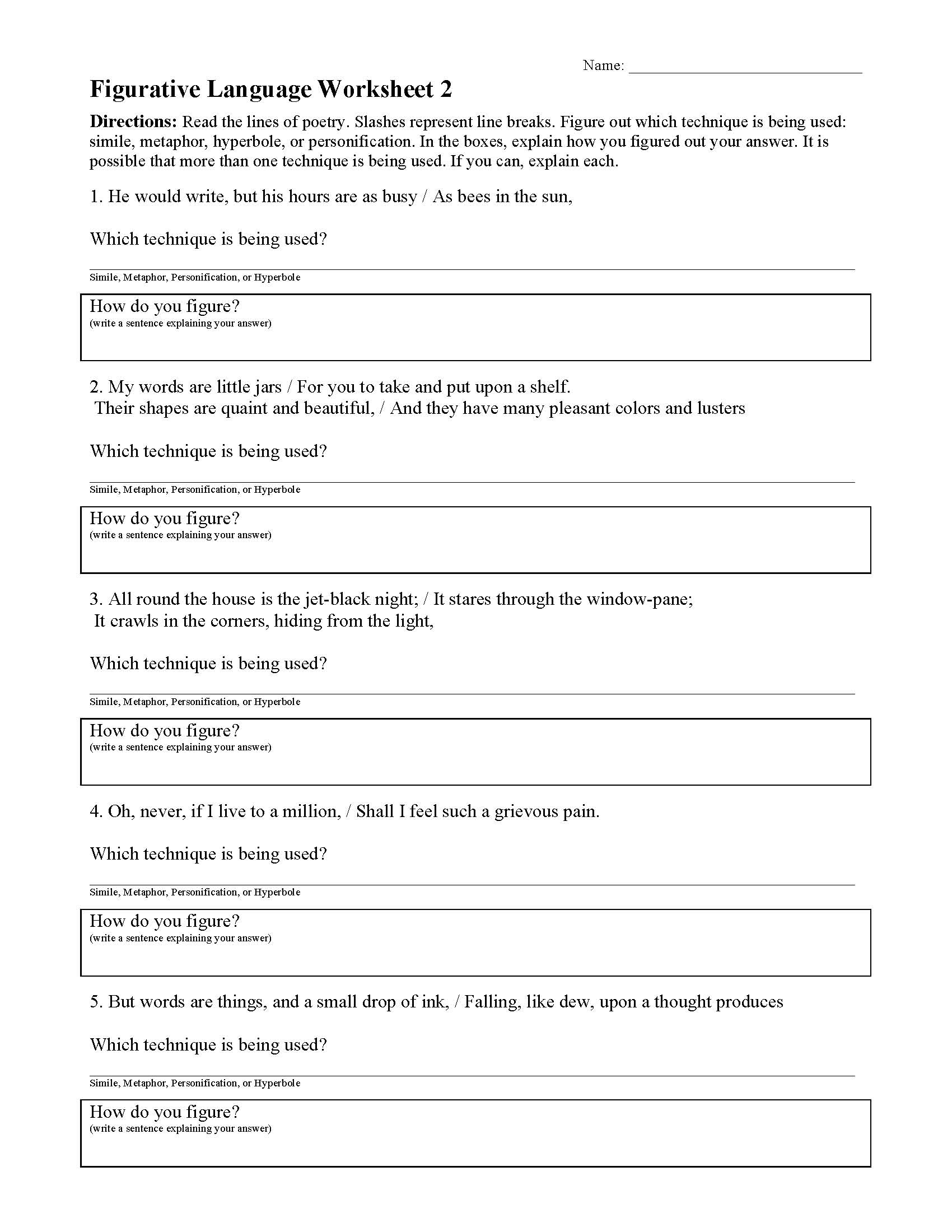
Figurative Language Worksheet 3
This worksheet packs a double dose of figurative language practice: four sides and 27 problems! Students determine whether each snippet contains an example of simile, metaphor, personification, hyperbole, or idiom. Students are also required to explain their responses.
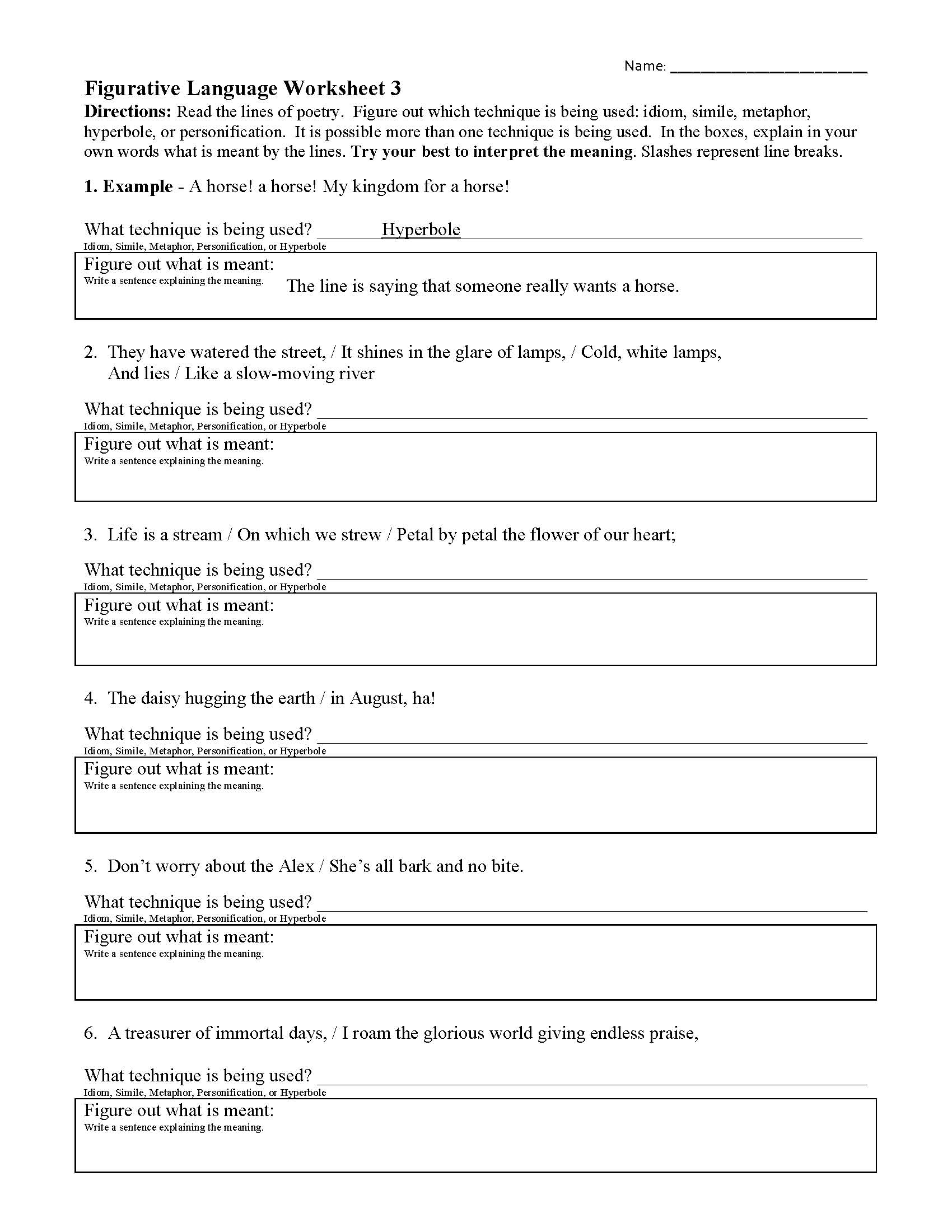
Figurative Language Worksheet 4
This worksheet has ten more practice problems from classic poems to help students master figurative language. Students will read the examples, identify the figuartive techniques, and then explain how they got their answers.

Figurative Language Worksheet 5
Here is another worksheet with 10 more practice problems to help students master figurative language. Students will read the examples, determine the figurative language technique, and then explain their answers.
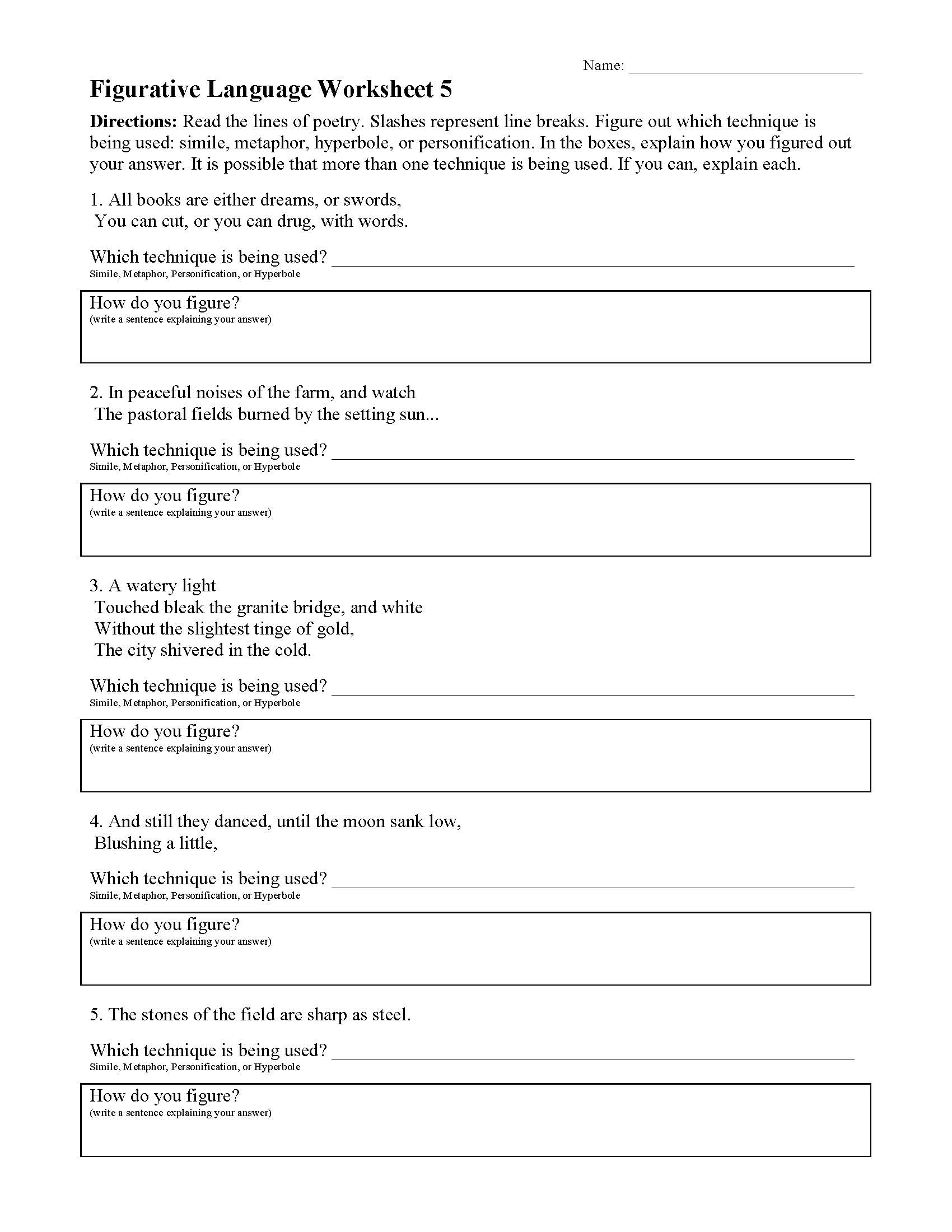
Figurative Language Worksheet 6
Do you need more practice with figurative language? This 23 problem worksheet with four pages should keep students busy for a little while. Students will identify the figurative language technique used in each of the 23 examples and then explain how they got their answers.
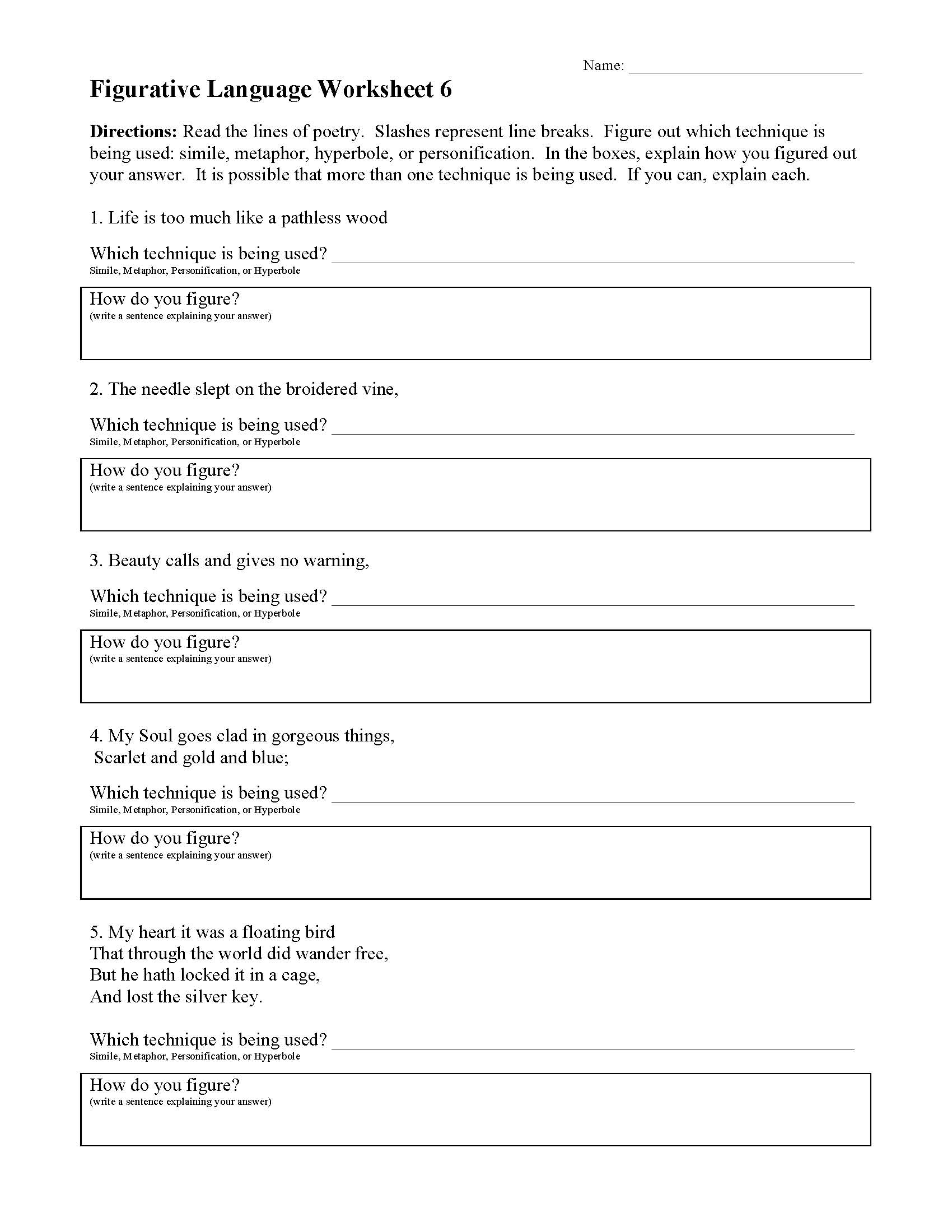
Figurative Language Worksheet 7
What's better than figurative language practice? More figurative language practice! Here is another double-sided figurative language worksheet with ten problems. The language used in this worksheet is easier to understand.
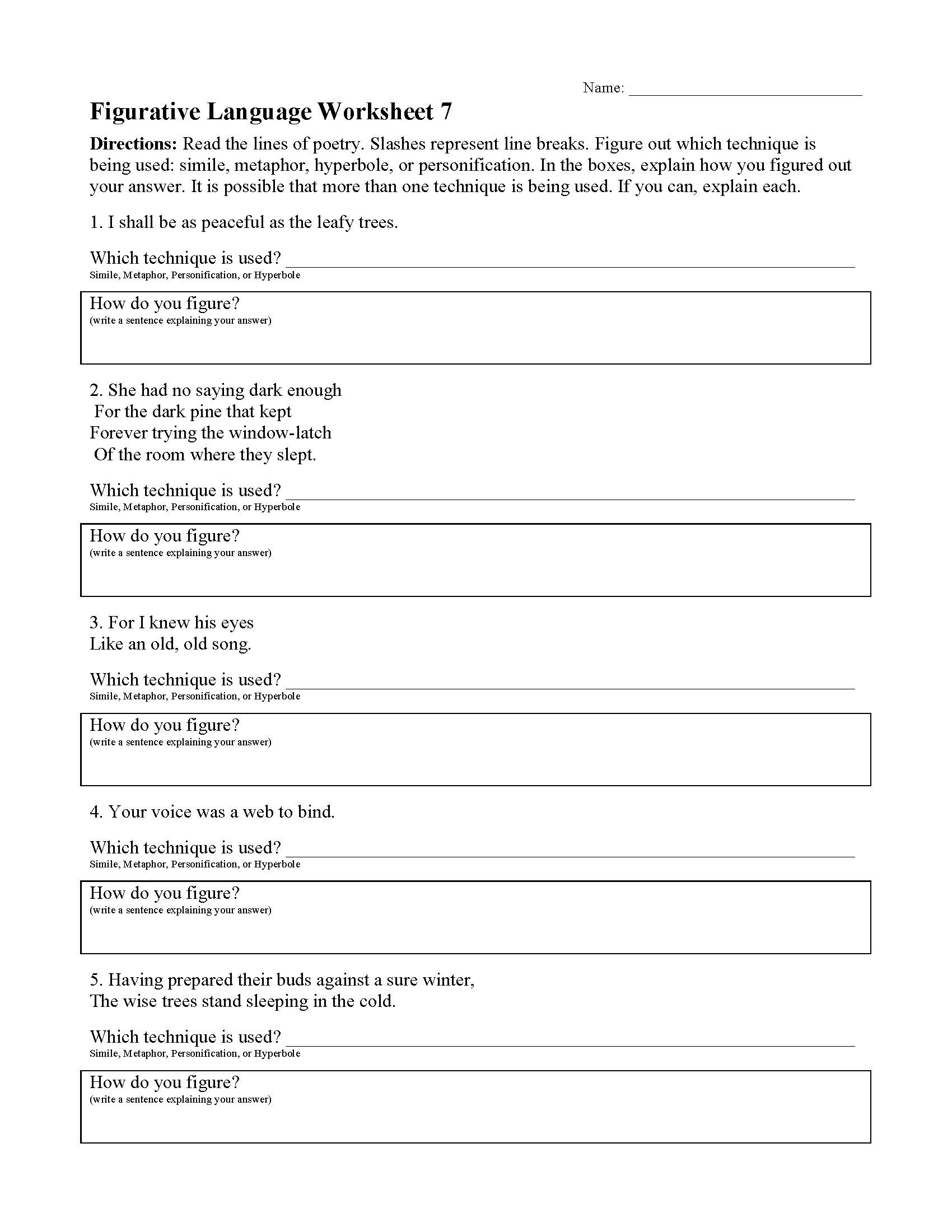
Figurative Language Worksheet 8
Here is yet another four-page figurative language worksheet. It has 22 figurative langauge techniques used in a variety of contexts. Students read each example, identify the technique that is being used, and then explain how they got their answers.

Figurative Language Worksheet 9
Are you still looking for practice with figurative language? This two-page, double-sided worksheet has 22 more figurative language problems. Students read the poetry snippets, identify the figurative language techniques, and then explain their answers.
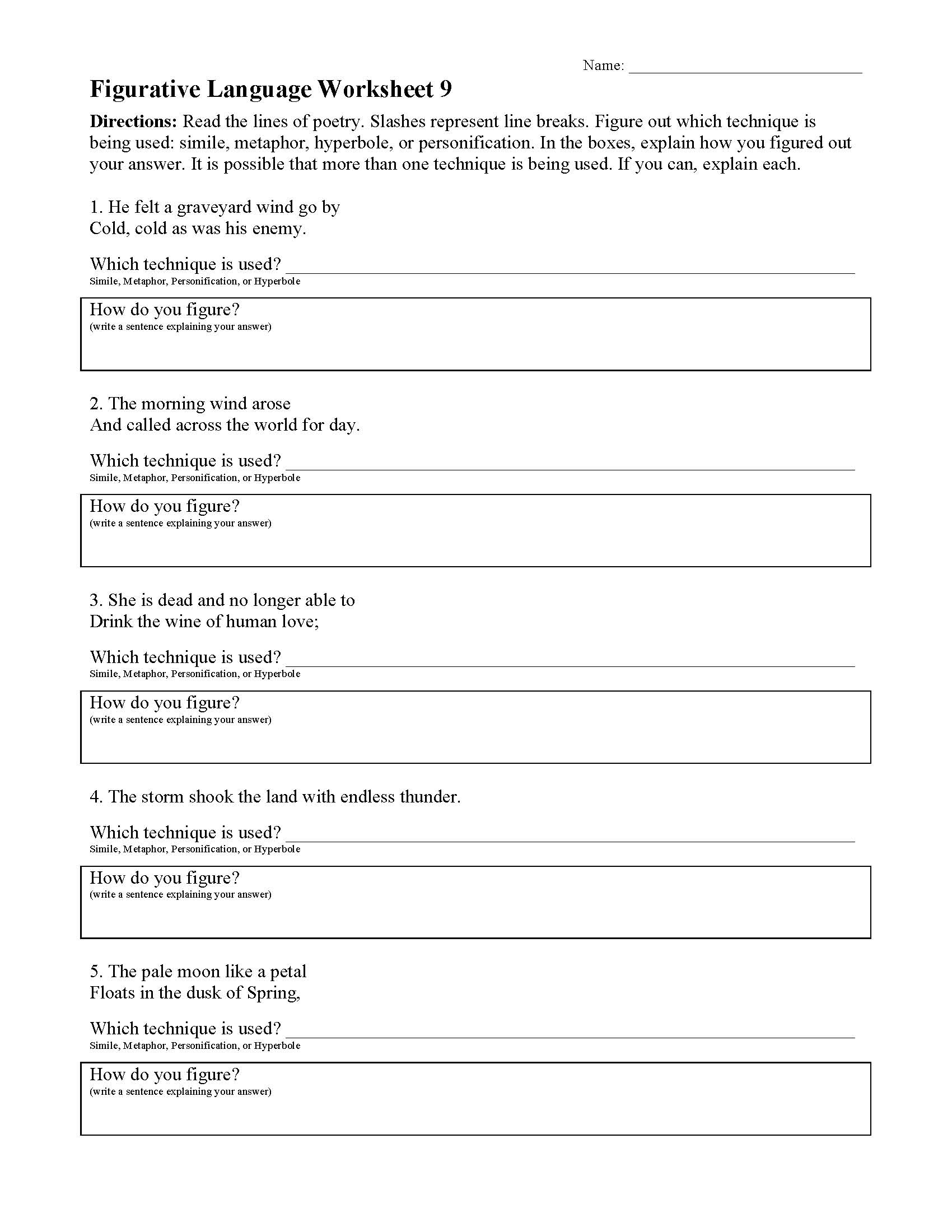
"Lord of the Flies" Figurative Language Worksheet
Here's a four page, 26 question worksheet featuring examples of figurative language taken from one of my favorite books, "Lord of the Flies." Students determine what figure of speech is used and explain their answers.
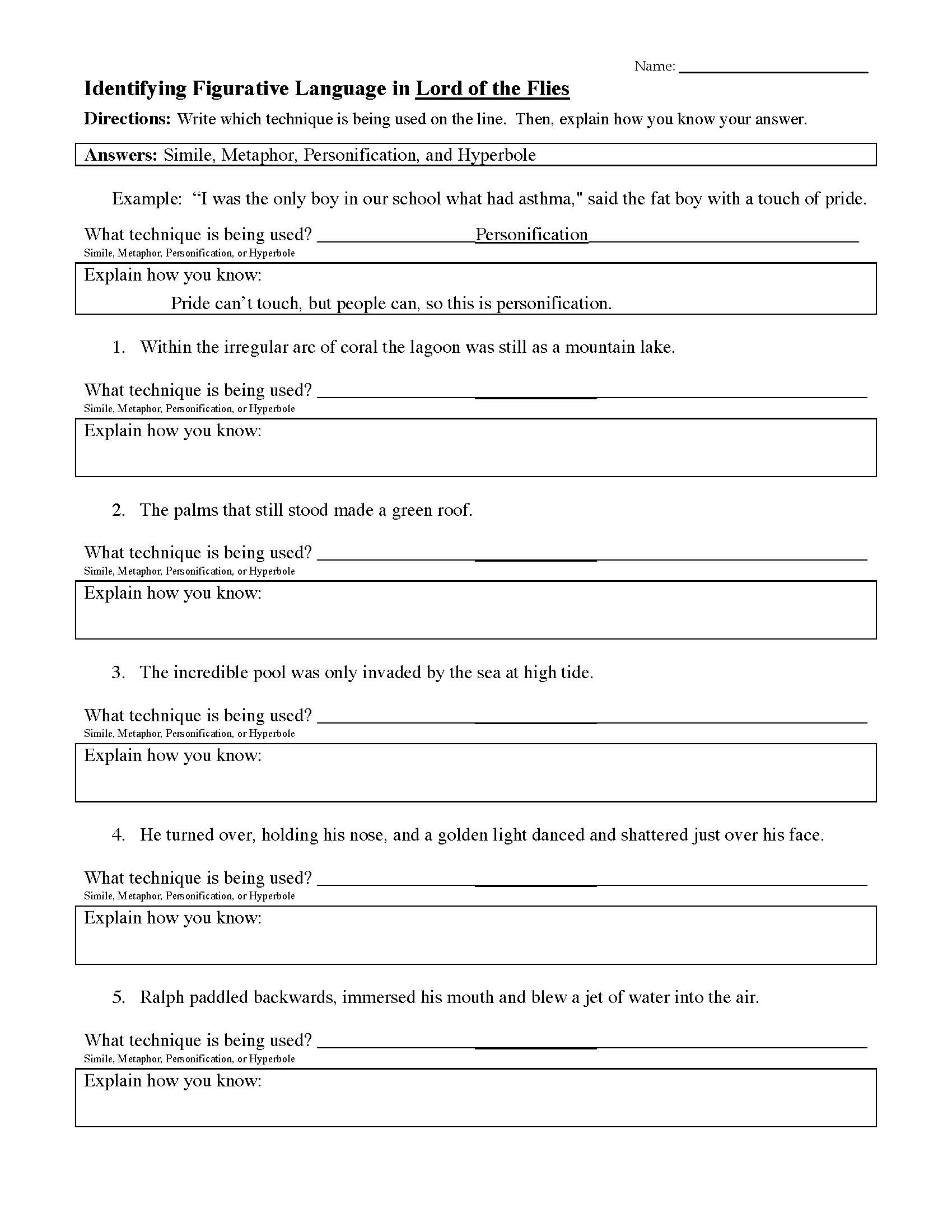
Figurative Language of Edgar Allan Poe Worksheet
Here's a figurative language worksheet featuring lines from stories and poems of Edgar Allen Poe. Students write which technique is being used on the line and then explain how they figured out the answer. This is a great activity to use alongside one of Poe's stories.
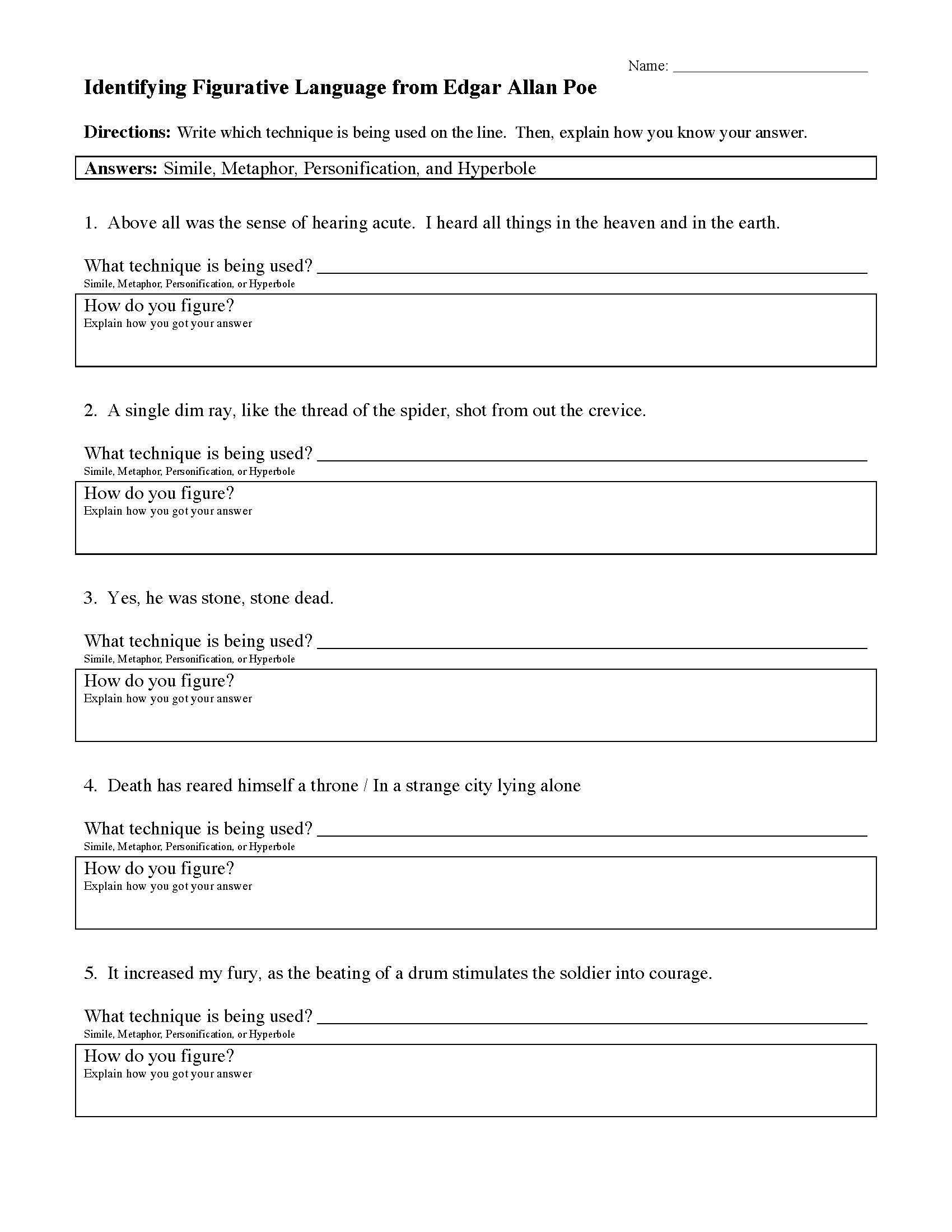
Figurative Language of O. Henry
This worksheet features twenty-three selected examples of figurative language from O. Henry, one of the master writers of the short story. This four-page worksheet will give students plenty of practice with working with figurative language and poetic devices.
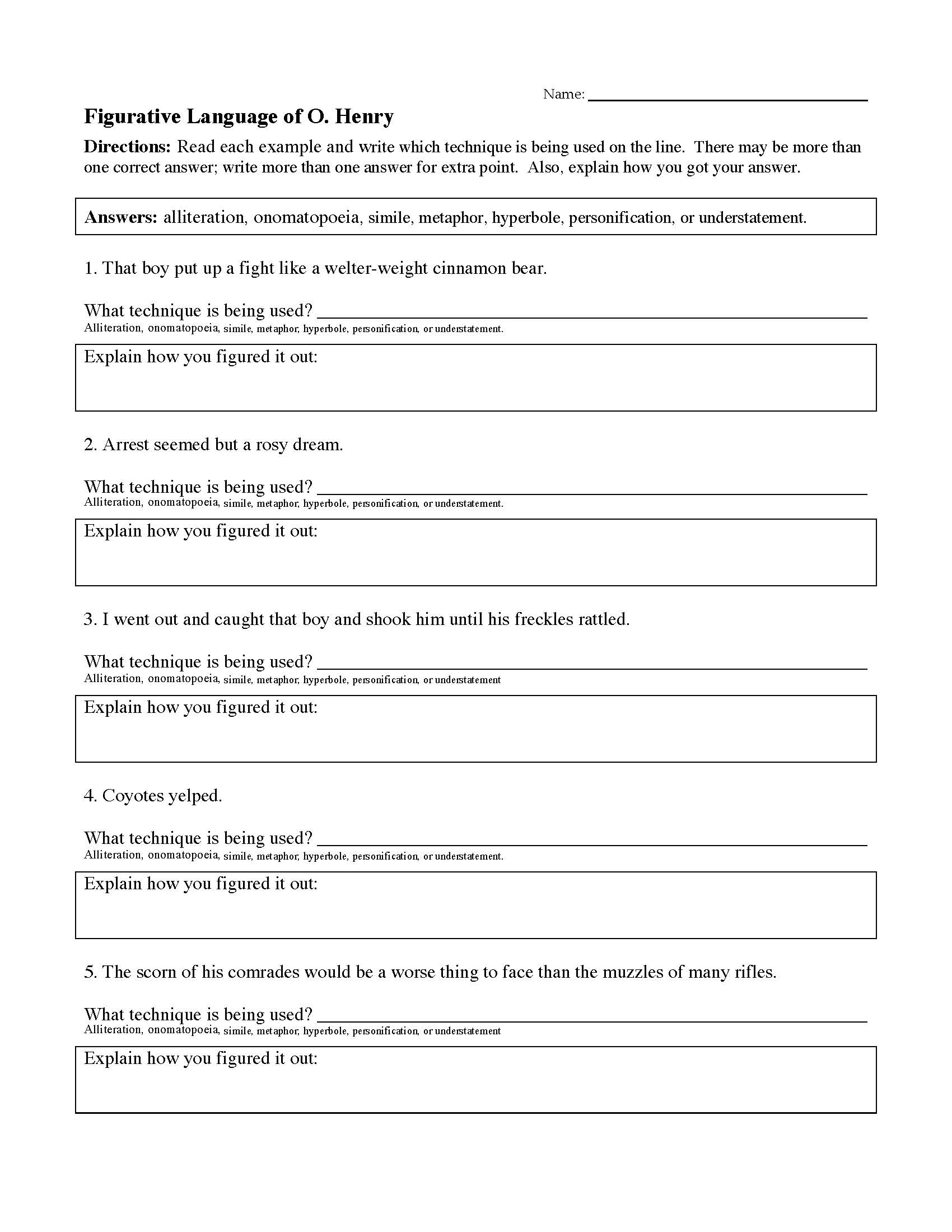
Figurative Language of Shakespeare
Shakespeare is not only a master of the theater, he is also a master of figurative language. His language is also a bit more difficult for most students to decode, so this is not a recommended activity for novices. Here are 23 figurative language examples used in Shakespeare's tragedies, comedies, history plays, and sonnets.
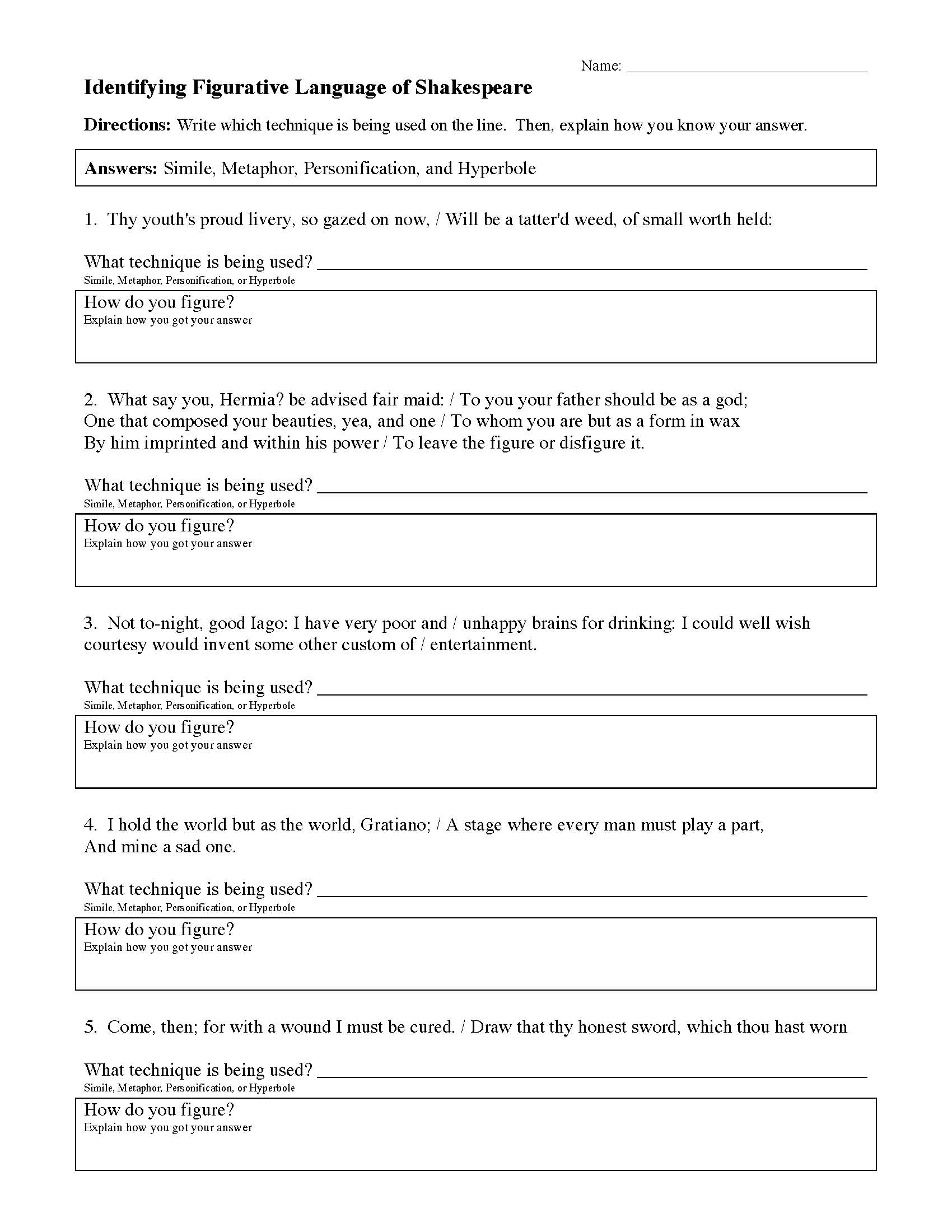
Figurative Language and Poetic Devices Review Games
Orpheus The Lyrical: Figurative Language Video Game
Here is a high-interest figurative language video game that I wrote. Students play as the mythical Orpheus in his quest to retrieve his beloved Eurydice from Hades. They will answer literally hundreds of figurative language questions along the way. This is a fun and exciting way to review figurative language techniques and students really get into it.
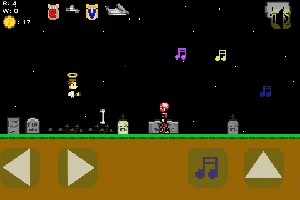
Poetry Cat: Poetic Devices Video Game
This is a fun and free browser game to help you review poetic devices. Students play as a cat and try to collect balls of yarn. When they get hit by an enemy, they have to answer a question to proceed. This game is fun, engaging, and has hundreds of questions on poetic devices. Very educational!
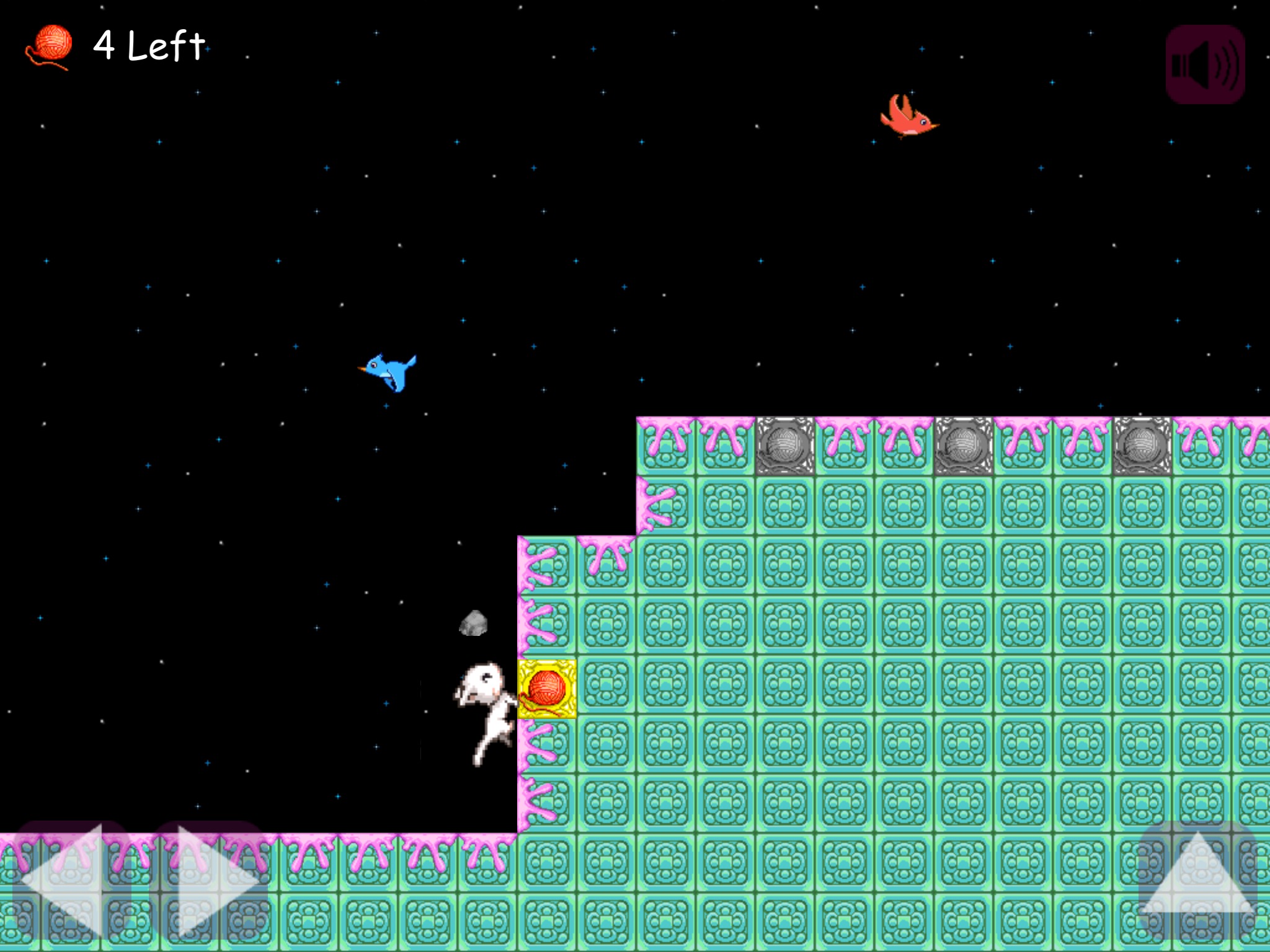

Figurative language can add magic to your writing.
Figurative Language
Common Core State Standards
Figurative Language Anchor Standards
R.4 - Interpret words and phrases as they are used in a text, including determining technical, connotative, and figurative meanings, and analyze how specific word choices shape meaning or tone.RL.2.4 - Describe how words and phrases (e.g., regular beats, alliteration, rhymes, repeated lines) supply rhythm and meaning in a story, poem, or song.
RL.3.4 - Determine the meaning of words and phrases as they are used in a text, distinguishing literal from nonliteral language.
RL.4.4 - Determine the meaning of words and phrases as they are used in a text, including those that allude to significant characters found in mythology (e.g., Herculean).
RL.5.4 - Determine the meaning of words and phrases as they are used in a text, including figurative language such as metaphors and similes.
RL.6.4 - Determine the meaning of words and phrases as they are used in a text, including figurative and connotative meanings; analyze the impact of a specific word choice on meaning and tone.
RL.7.4 - Determine the meaning of words and phrases as they are used in a text, including figurative and connotative meanings; analyze the impact of rhymes and other repetitions of sounds (e.g., alliteration) on a specific verse or stanza of a poem or section of a story or drama.
RL.8.4 - Determine the meaning of words and phrases as they are used in a text, including figurative and connotative meanings; analyze the impact of specific word choices on meaning and tone, including analogies or allusions to other texts.
RL.9-10.4 - Determine the meaning of words and phrases as they are used in the text, including figurative and connotative meanings; analyze the cumulative impact of specific word choices on meaning and tone (e.g., how the language evokes a sense of time and place; how it sets a formal or informal tone).
RL.11-12.4 - Determine the meaning of words and phrases as they are used in the text, including figurative and connotative meanings; analyze the impact of specific word choices on meaning and tone, including words with multiple meanings or language that is particularly fresh, engaging, or beautiful. (Include Shakespeare as well as other authors.)
Click to VIEW Grade Level Standards for R.4
L.5 - Demonstrate understanding of figurative language, word relationships, and nuances in word meanings.
L.3.5a - Distinguish the literal and nonliteral meanings of words and phrases in context (e.g., take steps).
L.4.5 - Demonstrate understanding of figurative language, word relationships, and nuances in word meanings.
L.4.5a - Explain the meaning of simple similes and metaphors (e.g., as pretty as a picture) in context.
L.5.5a - Interpret figurative language, including similes and metaphors, in context.
L.6.5 - Demonstrate understanding of figurative language, word relationships, and nuances in word meanings.
L.6.5a - Interpret figures of speech (e.g., personification) in context.
L.7.5 - Demonstrate understanding of figurative language, word relationships, and nuances in word meanings.
L.7.5a - Interpret figures of speech (e.g., literary, biblical, and mythological allusions) in context.
L.8.5 - Demonstrate understanding of figurative language, word relationships, and nuances in word meanings.
L.8.5a - Interpret figures of speech (e.g. verbal irony, puns) in context.
L.9-10.5 - Demonstrate understanding of figurative language, word relationships, and nuances in word meanings.
L.11-12.5 - Demonstrate understanding of figurative language, word relationships, and nuances in word meanings.
L.11-12.5a - Interpret figures of speech (e.g., hyperbole, paradox) in context and analyze their role in the text.
L.3.5a - Distinguish the literal and nonliteral meanings of words and phrases in context (e.g., take steps).
L.4.5 - Demonstrate understanding of figurative language, word relationships, and nuances in word meanings.
L.4.5a - Explain the meaning of simple similes and metaphors (e.g., as pretty as a picture) in context.
L.5.5a - Interpret figurative language, including similes and metaphors, in context.
L.6.5 - Demonstrate understanding of figurative language, word relationships, and nuances in word meanings.
L.6.5a - Interpret figures of speech (e.g., personification) in context.
L.7.5 - Demonstrate understanding of figurative language, word relationships, and nuances in word meanings.
L.7.5a - Interpret figures of speech (e.g., literary, biblical, and mythological allusions) in context.
L.8.5 - Demonstrate understanding of figurative language, word relationships, and nuances in word meanings.
L.8.5a - Interpret figures of speech (e.g. verbal irony, puns) in context.
L.9-10.5 - Demonstrate understanding of figurative language, word relationships, and nuances in word meanings.
L.11-12.5 - Demonstrate understanding of figurative language, word relationships, and nuances in word meanings.
L.11-12.5a - Interpret figures of speech (e.g., hyperbole, paradox) in context and analyze their role in the text.
Click to VIEW Grade Level Standards for L.5
Still looking for something?
Search here.
Search here.
Leave a comment
162 Comments
Leave a Reply
By Using This Website You Agree to the Terms of Use and are aware of our privacy policy.
Subscribe Now
Get emails about new stuff.
Don't worry. I hate spam too.
Some Other Useful Pages
- Author's Purpose Worksheets
- Characterization Worksheets
- Conflict Worksheets
- Fact and Opinion Worksheets
- Figurative Language Activities
- Figurative Language Poems with Questions
- Genre Activities
- Irony Worksheets
- Making Predictions
- Mood Worksheets
- Nonfiction Passages and Functional Texts
- Parts of Speech Worksheets
- Poetic Devices
- Point of View Worksheets
- School Project Ideas
- Setting Worksheets
- Simile and Metaphor Worksheets
- Story Structure Worksheets
- Text Structure Worksheets
- Theme Worksheets
- Tone Worksheets
- ALL PAGES AND WORKSHEETS
Search This Site




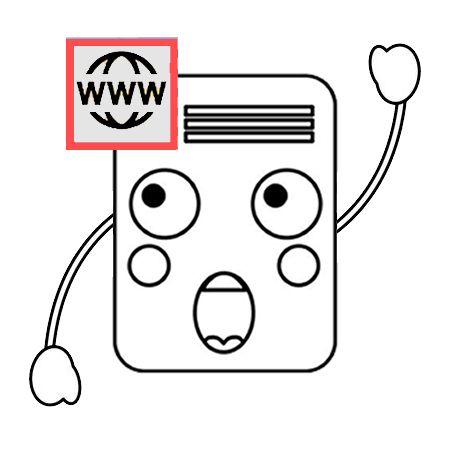

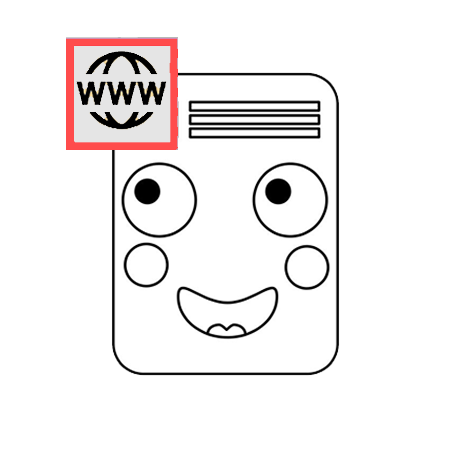
jacob michel
/ October 16, 2023is there a way to put some of these into schoology
Smith-Daniels
/ April 20, 2022I just stumbles upon this sight when I was browsing the web for figurative language worksheets. Thank you for those. But I am writing you to give you a BIG KUDOS for the Figurative Language ORPHEUS game. Yes my kids play kahoot….. but THIS GAME had them sooo excited. I can’t thank you enough and only wish I had discovered the site sooner.
Mr. Morton
/ April 20, 2022That’s awesome. Check out the Poetry Cat game too! I think they will like that.
Lisa
/ February 22, 2022Is there an Answer Key for the Figurative Language Test 1? I would like to use this for helping my students.
G. Mariano
/ November 26, 2020Figurative language Worksheet 1 #2 is in need of correction. The quote provided is an example of
onomatopoeia, which is not one of the choices.
“Drip—hiss—drip—hiss fall the raindrops / on the oaken log which burns, and steams,
and smokes the ceiling beams. / Drip—hiss—the rain never stops.”
AAZ
/ January 11, 2021We assumed here that the presence of another technique is simply beyond the scope of the question.
We’re sticking to the thought question (to match with the provided answers) and discussing what else we think we find (if we do).
We spotted this ‘bonus’ technique also.
Mr. Morton
/ August 5, 2021This question does contain onomatopoeia. And you can definitely discuss and share that.
It also contains hyperbole.
George Mariano
/ November 26, 2020Figurative language Worksheet 1 #1 must have the second line of the poem for it to be considered a simile.
“Like burnt-out torches by a sick man’s bed
Gaunt cypress-trees stand round the sun-bleached stone;”
The “burnt-out torches” and cypress trees are being compared, as are the sick man’s bed and Shelley’s “sun-bleached” grave stone.
Please see Wilde’s poem, “The Grave of Shelley”.
AAZ
/ January 11, 2021Thanks for the heads up 🙂
And thanks to this website for these exercises.
Very happy to find this resource for our homeschool project and great to see it is alive with feedback.
Really appreciate the effort.
Dakota bates
/ January 20, 2020This was veery helpfully with my test
Lorevic Arreza
/ August 25, 2019These figurative Languages are very much helpful for my pupils and a great help for my reference. Thank you so much and keep up the excellent work. God bless!
Emma
/ June 12, 2019just studying for a final LOL
ali
/ June 13, 2017Thank you very much for providing the worksheets. It is very helpful. Gob Bless and keep up the good work.
Akber Ali
/ March 4, 2017I am deeply touched to have seen this work. This is simply amazing…… I am so thankful.
Samarth Roy
/ February 15, 2017I just wanna say……..”Doctor MOrton my literary misconceptions are afraid of you just like computer viruses from NORTON.
Christy Smith
/ November 16, 2016Thank you for all your hard work on this site! I have used it for years in my classroom and find it the best way to teach poetic terms.
Mr. Morton
/ March 22, 2017I’m so happy to hear it. Thank you for visiting and taking the time to comment. Best wishes!
Ann
/ October 27, 2016Is there a way to load these worksheets to my google classroom
Mr. Morton
/ October 27, 2016Some of the activities on this page can be uploaded to Google Classroom: http://www.ereadingworksheets.com/e-reading-worksheets/online-reading-tests/
Specifically, the short stories and point of view practice activities.
I aim to support Google Classroom across the site one day…
TJ
/ September 20, 2016I honestly could not survive as a teacher without your items — I utilize it in so many ways!
Dr. Seema Singh
/ June 25, 2016Very useful worksheets to give ample practice to my students. Saves a lot of time !!
Thanks a lot
Sam
/ May 29, 2016I cannot even begin to imagine how many hours and days and years this has taken you. To say that I am grateful, Mr. Morton, is an understatement. Because of your efforts, I believe thousands upon thousands of students are getting a better education. (This comes from a beginning teacher with little experience putting together language units). Praise God for your generosity, kindness and effort.
kolton
/ January 26, 2016thank you for providing these worksheets as a resource for students like me 🙂
B. Futrell
/ September 27, 2015This is an amazing resource! Thank you so much!